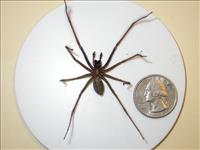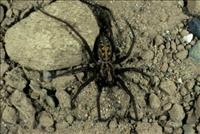|
|
|
|
|

Caption: Giant house spider
Photo by: T. Murray
|
|
Giant house spider
(revision date: 1/11/2019)
Use Integrated Pest Management (IPM) for successful pest management.
Biology
The giant house spider,Eratigena atrica (formally known as Tegenaria gigantea and T. duellica), is commonly found in and around Washington homes west of the Cascade Mountains. Its range also includes parts of coastal Canada and Oregon. They are not found east of the Cascades in Washington. It is often seen in mid-summer to early fall, when males in particular are highly mobile. These brown to grayish-brown spiders are highly variable in size and color. The body is typically around 1/2 inch to 1 inch in length (not including the legs); while the leg span for large adults can reach up to 4 inches. The smaller males are often mistaken for hobo spiders; however, in the Puget Sound region giant house spiders outnumber hobo spiders and are much more frequently encountered. The legs and body of the giant house spider are somewhat hairy and are not shiny in appearance. The color varies widely from light to dark, with markings on the body and legs ranging from barely visible to very distinct. Because of the variability in color, size, and markings, none of these are reliable features for identifying this spider. Giant house spiders prefer dark areas for web-building and are ideally adapted to life indoors. They are often found in garages or basements, as well as outdoors in firewood or in gaps between bricks or stones. They build sheets of webbing with a funnel-like hole in the center, where the spider sits waiting for prey. The giant house spider is not an extremely active climber and indoors is usually found on the floor or trapped in sinks or bathtubs where it has ventured in search of water. These spiders are not aggressive and usually run away (very quickly) when startled. The bite of the giant house spider is not known to pose any threat to humans. However, if you are bitten by a spider, bring the spider to an expert for correct identification and you may wish to seek medical attention. Spiders are considered beneficial because they are predators. However, they can also be a nuisance pest indoors. Giant house spiders are frequently mistaken for hobo spiders. For more information, see the following publication: Common Spiders of Washington EM113E at http://pubs.wsu.edu.
|
|
|
Management Options
Non-Chemical Management
- Giant house spiders are considered beneficial organisms and as such, should be left alone as much as reasonably possible. Indoors, control measures are best limited to mechanical means if tolerance is not an option. Outdoor control of spiders (chemically or otherwise) is neither recommended nor realistic.
- Glue-based or sticky traps are commercially available for spider control. These may help control indoor populations of wandering spiders. Place traps in locations frequented by spiders, such as the dark, protected corners in the garage.
- Many spiders and insects are brought into the home on firewood. Use gloves when handling firewood and inspect each log before moving it into the house. Only bring in sufficient wood for immediate use.
- “Spider-proof” your house as much as possible by making sure openings into the home are sealed or screened and window and door screens are intact and tight-fitting. Reduce gaps at door thresholds by checking that door sweeps and/or weather-stripping are intact. Caulk or repair cracks and openings around water lines, gas pipes, electric wiring, and window and door frames.
- Spiders in the home can be removed by capturing and releasing them outdoors, or they can be controlled mechanically by using a vacuum, fly swatter or broom.
Select non-chemical management options as your first choice!
Chemical Management
Pesticide applications are a temporary fix unless efforts are made to prevent spider entry into the house. Spraying spiders outdoors is not usually advised and extremely temporary in nature unless performed by a pest control company on a regular basis.
|
|
Images
+ Show larger images
| |

Caption: Giant house spider
Photo by: T. Murray
|

Caption: Giant house spider
Photo by: Art Antonelli
|
|
|
|
|
